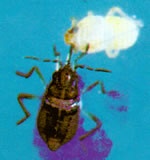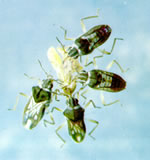An important predator of hopper nymphs
Another common, important, yet smaller predator is the broad-shouldered
water strider Microvelia douglasi atrolineata Bergroth, family
Veliidae. It primarily attacks hopper nymphs.
In the photo below, see the Microvelia sucking the body fluids
from a small brown planthopper nymph.
 |
 |
| Microvelia douglasi atrolineata | Several predators usually attack larger hoppers at one time. |
Habitat
Results in insectary cages
| Natural reduction in brown planthopper Nilaparvata lugens nymph density in field cages caused by predators, especially Microvelia atrolineata, over 18 days in wetland rice. | |||
|
Brown
planthopper density (no./4 hills)
|
Reduction in density
(%)
|
||
|
Few Predators
(2/4 hills) (closed cage) |
Many Predators
(34/4 hills) (open cage) |
Difference
|
|
|
86
|
36
|
50
|
58
|
Next lesson